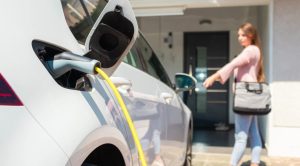Table of Contents
The shift towards electric vehicles (EVs) isn’t just a trend, it’s rapidly becoming a necessity for businesses looking to reduce emissions, cut costs, and future-proof their operations.
If your business operates a commercial fleet, ensuring the efficiency of your EV charging setup is crucial.
With proper planning, investment in the right infrastructure, and an emphasis on optimisation, you can save time, reduce expenses, and maximise your fleet’s potential.
This guide explores how to optimise your electric vehicle charging hub and why it matters for the success of your commercial fleet.
Why Optimising EV Charging Infrastructure Matters?

Transitioning to EVs has many benefits for commercial fleets, but without the appropriate electrical infrastructure, you risk inefficiencies that could offset these advantages. Key benefits of optimising your charging infrastructure include:
- Cost Savings: Streamlined operations mean you spend less on energy and vehicle downtime.
- Improved Fleet Productivity: Well-planned charging schedules and infrastructure ensure your vehicles are ready when they’re needed.
- Environmental Impact: A perfectly tuned charging setup supports your sustainability goals, reducing emissions and your business’s carbon footprint.
- Future Proofing: As technology evolves, having scalable infrastructure ensures you’re prepared for increasing demand or newer vehicle technologies.
To fully unlock these benefits, careful consideration must be given to planning and implementing the right charging solutions for your commercial needs.
Steps to Optimise Your EV Charging Infrastructure
If you’re looking to make the most of your electric vehicle charging hub, here are some key strategies to consider:
1. Understand Fleet Requirements
Start by analysing your fleet’s size, usage patterns, and energy demands. Do vehicles operate within a small radius, or are longer trips a regular requirement? Understanding this determines the type and number of chargers you’ll need and ensures your electrical infrastructure is equipped to handle fleet requirements.
For example:
- Fast chargers may be required for fleets with a quick turnaround time.
- Overnight slow chargers are better suited to fleets that remain stationary for extended periods.
Mapping these requirements helps prevent future bottlenecks and ensures efficiency from day one.
2. Invest in Scalable Electrical Infrastructure
Your electrical infrastructure lays the foundation of your charging hub. Install systems that not only support today’s fleet but have the capacity to meet future demands as your business grows or EV adoption increases.
- Load Management: Avoid costly upgrades to your entire system by implementing load management software that distributes available electricity based on vehicle priority.
- Energy Storage Solutions: Adding battery storage can help reduce grid reliance and improve fee predictability by allowing off-peak energy usage for daily charging.
By planning for scalability, your electric vehicle charging hub will serve your commercial fleet effectively both now and in years to come.
3. Location, Location, Location
Where you place your charging stations matters just as much as how many you have. It’s about convenience and efficiency.
Chargers located close to operational centres or hubs save travel time and reduce unnecessary mileage.
If your fleet frequents external locations, consider public charging partnerships or on-the-move charging solutions, but keep your internal charging hub as a reliable base for maximum efficiency.
4. Implement Smart Charging Solutions
Modern technology can turn a simple EV charger into a powerhouse of efficiency. Smart charging solutions can optimise charging times by identifying off-peak electricity hours, reducing costs.
They can also monitor charging patterns and predict future energy demands, ensuring you’re always ahead of the game.
Platforms offering data and insights into energy usage can also highlight potential inefficiencies in your setup, making adjustments quicker and more manageable.
5. Regular Maintenance and Upgrades
Like any technology, EV chargers need to be maintained to keep them running smoothly. Whether it’s software updates or the occasional hardware service, keeping your electric vehicle charging hub in top condition ensures its longevity and consistency.
Upgrade options might include:
- Compatibility with newer EV models.
- Faster charging capabilities.
- Adding renewable energy sources like solar power.
Consistent maintenance minimises system downtime and keeps your fleet moving at optimal productivity.
6. Explore Renewable Energy Integration
Integrating renewable energy sources such as solar panels or wind turbines into your charging system can significantly reduce your reliance on the grid.
While it may require a larger initial investment, the long-term savings and reduced environmental impact make it well worth considering.
Pair renewable energy with energy storage systems to create an independent, self-sustaining solution for your EV charging hub.
Benefits for Commercial Fleets

By optimising your EV charging infrastructure, your business can unlock tangible benefits that go beyond just powering vehicles:
- Reduced Operating Costs: Smart charging and renewable energy integration help keep electricity bills in check.
- Enhanced Fleet Uptime: Efficient charging schedules mean less downtime waiting for a charge and more time on the road.
- Stronger Competitive Edge: With streamlined operations and a clear commitment to sustainability, your business builds a reputation as an industry leader.
- Employee Satisfaction: Simplified processes and greener initiatives often foster a sense of pride for staff invested in the company’s vision.
Final Thoughts
Electric vehicles are more than just a sustainable option, they’re a smart business decision. But to harness their full potential, your charging infrastructure needs careful planning and regular optimisation.
From understanding fleet requirements to investing in scalable solutions and leveraging smart tools, the right strategies can make a world of difference.


